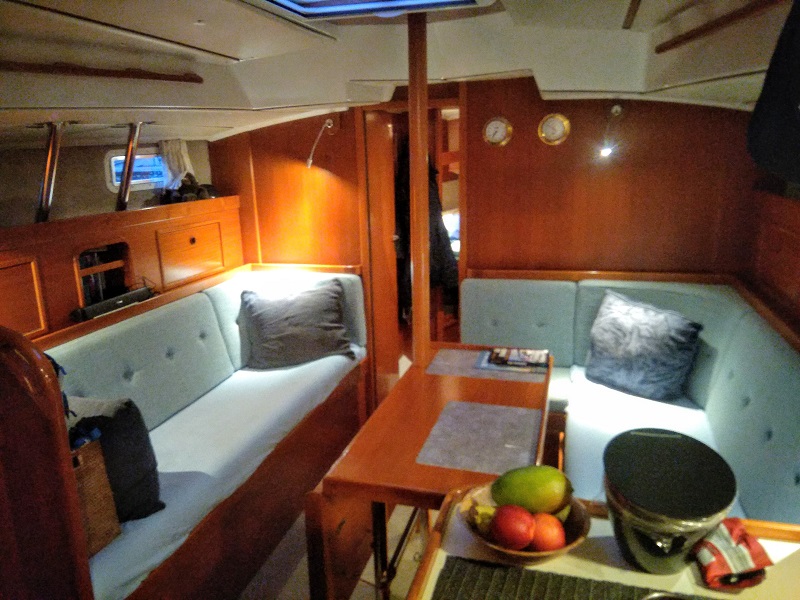Review of Contest 36 S
Basic specs.

If you have a photo you would like to share: Upload Image
Looking for a new boat? Find a Contest 36 S or similar boat for sale

One option is a fractional rig. A fractional rig has smaller headsails which make tacking easier, which is an advantage for cruisers and racers, of course. The downside is that having the wind from behind often requires a genaker or a spinnaker for optimal speed.
Another option is a masthead rig. The advantage of a masthead rig is its simplicity and the fact that a given sail area - compared with a fractional rig - can be carried lower and thus with less heeling moment.
Sailing characteristics
This section covers widely used rules of thumb to describe the sailing characteristics. Please note that even though the calculations are correct, the interpretation of the results might not be valid for extreme boats.
What is Capsize Screening Formula (CSF)?
The capsize screening value for Contest 36 S is 1.84, indicating that this boat could - if evaluated by this formula alone - be accepted to participate in ocean races.
What is Theoretical Maximum Hull Speed?
The theoretical maximal speed of a displacement boat of this length is 7.2 knots. The term "Theoretical Maximum Hull Speed" is widely used even though a boat can sail faster. The term shall be interpreted as above the theoretical speed a great additional power is necessary for a small gain in speed.
The immersion rate is defined as the weight required to sink the boat a certain level.
The immersion rate for Contest 36 S is about 210 kg/cm, alternatively 1178 lbs/inch.
Meaning: if you load 210 kg cargo on the boat then it will sink 1 cm.
Alternatively, if you load 1178 lbs cargo on the boat it will sink 1 inch.
Sailing statistics
This section is statistical comparison with similar boats of the same category. The basis of the following statistical computations is our unique database with more than 26,000 different boat types and 350,000 data points.
What is Motion Comfort Ratio (MCR)?
The Motion Comfort Ratio for Contest 36 S is 30.1.
What is L/B (Length Beam Ratio)?
The l/b ratio for Contest 36 S is 3.08.
What is Displacement Length Ratio?
The DL-ratio for Contest 36 S is 289 which categorizes this boat among 'medium weight cruisers'.
What is SA/D (Sail Area Displacement ratio)?
The SA/D for Contest 36 S with ISO 8666 reference sail is 16.4, with a 135% genua the SA/D is 18.7.
Maintenance
Dimensions of sail for fractional rig.


Are your sails worn out? You might find your next sail here: Sails for Sale
If you need to renew parts of your running rig and is not quite sure of the dimensions, you may find the estimates computed below useful.
| Fractional rig | ||||
| Usage | Length | Diameter | ||
| Mainsail halyard | 37.0 m | (121.6 feet) | 12 mm | (1/2 inch) |
| Jib/genoa halyard | 37.0 m | (121.6 feet) | 12 mm | (1/2 inch) |
| Spinnaker halyard | 37.0 m | (121.6 feet) | 12 mm | (1/2 inch) |
| Jib sheet | 10.9 m | (35.8 feet) | 14 mm | (0.55 inch) |
| Genoa sheet | 10.9 m | (35.8 feet) | 14 mm | (0.55 inch) |
| Mainsheet | 27.3 m | (89.5 feet) | 14 mm | (0.55 inch) |
| Spinnaker sheet | 24.0 m | (78.7 feet) | 14 mm | (0.55 inch) |
| Cunningham | 5.1 m | (16.6 feet) | 12 mm | (1/2 inch) |
| Kickingstrap | 10.1 m | (33.2 feet) | 12 mm | (1/2 inch) |
| Clew-outhaul | 10.1 m | (33.2 feet) | 12 mm | (1/2 inch) |
| Masthead rig | ||||
| Usage | Length | Diameter | ||
| Mainsail halyard | 32.7 m | (107.2 feet) | 12 mm | (1/2 inch) |
| Jib/genoa halyard | 32.7 m | (107.2 feet) | 12 mm | (1/2 inch) |
| Spinnaker halyard | 32.7 m | (107.2 feet) | 12 mm | (1/2 inch) |
| Jib sheet | 10.9 m | (35.8 feet) | 14 mm | (0.55 inch) |
| Genoa sheet | 10.9 m | (35.8 feet) | 14 mm | (0.55 inch) |
| Mainsheet | 27.3 m | (89.5 feet) | 14 mm | (0.55 inch) |
| Spinnaker sheet | 24.0 m | (78.7 feet) | 14 mm | (0.55 inch) |
| Cunningham | 3.5 m | (11.5 feet) | 12 mm | (1/2 inch) |
| Kickingstrap | 7.0 m | (23.1 feet) | 12 mm | (1/2 inch) |
| Clew-outhaul | 7.0 m | (23.1 feet) | 12 mm | (1/2 inch) |
This section shown boat owner's changes, improvements, etc. Here you might find inspiration for your boat.
Do you have changes/improvements you would like to share? Upload a photo and describe what to look for.
We are always looking for new photos. If you can contribute with photos for Contest 36 S it would be a great help.
If you have any comments to the review, improvement suggestions, or the like, feel free to contact us. Criticism helps us to improve.
